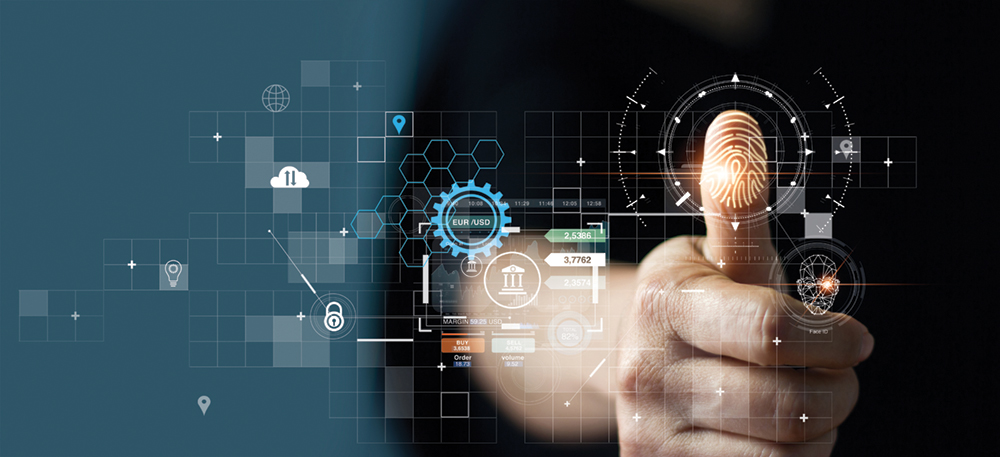
The need for robust and secure identification methods in a rapidly evolving technological landscape has become paramount. Biometrics, the measurement and statistical analysis of people’s unique physical and behavioural characteristics, has emerged as a cutting-edge solution. At its core, biometrics is the science of measuring and analysing biological data to establish and verify an individual’s identity. Physiological biometrics involves the analysis of physical attributes. Fingerprint recognition, one of the oldest and most widely adopted methods, relies on the distinct patterns found on fingertips. Iris and retina scans capture the unique features of the eyes, such as blood vessel patterns or iris characteristics.
Facial recognition technology, another prevalent method, analyses unique facial features for identification. While not as commonly employed, DNA matching stands out for its unparalleled accuracy. On the other hand, behavioural biometrics focuses on an individual’s behavioural patterns.
Voice recognition systems, for instance, analyse unique voice characteristics, including pitch and tone. Keystroke dynamics scrutinise typing patterns, while signature dynamics and gait analysis involve the study of an individual’s unique way of signing or walking, respectively.
Nepal is progressively integrating biometric technology into various aspects of its society. One notable application is in the domain of national identification. The government has implemented biometric systems to enhance the accuracy and security of identification processes, particularly while issuing national identification cards and passports. Along with reinforcing the nation’s security infrastructure, the move also streamlines bureaucratic procedures, contributing to more efficient and reliable citizen identification.
In addition to national identification, the financial sector in Nepal is witnessing a surge in the adoption of biometrics. Banks and financial institutions have leveraged biometric authentication for secure and seamless financial transactions. The application includes using fingerprint recognition and other biometric methods to authenticate individuals accessing their bank accounts, making transactions, or using mobile banking services. Integrating biometrics in the financial sector aligns with global trends in modernising and digitising financial services. As Nepal embraces the advantages of biometric technology, it stands at the forefront of leveraging these innovations to strengthen national security and the efficiency of essential services.
The applications of biometrics span multitude sectors. In security, biometric authentication has found extensive use in access control systems for buildings, data centres and secure facilities. The reliability and uniqueness of biometric traits such as fingerprints and iris scans make them ideal for securing physical spaces. Mobile devices have integrated biometrics for user authentication, providing a convenient and secure alternative to traditional passwords. Smartphones commonly employ fingerprint or facial recognition technology, enhancing the overall security of these devices. The financial sector has embraced biometrics for secure authentication during transactions. Voice recognition and fingerprint scanning have become commonplace in mobile banking applications, ensuring secured financial interactions.
In healthcare, biometrics plays a crucial role in patient identification and securing sensitive medical information. Fingerprint scanning, for instance, is employed in medication dispensing systems to ensure accurate and secure administration. Border control and immigration processes have also benefited from biometric technology. Airports and immigration checkpoints use facial recognition and fingerprint scanning to streamline identity verification, enhancing security and efficiency. In workplace environments, biometrics is utilised for time and attendance tracking. It ensures accurate record-keeping and prevents fraudulent practices like buddy punching.
Biometric systems offer several advantages that contribute to their widespread adoption. One notable benefit is their high accuracy rates, reducing the likelihood of false positives or negatives. The security offered by biometrics is robust, as the unique nature of biometric traits makes it challenging for unauthorised users to gain access. Moreover, biometric authentication is often more convenient than traditional methods.
Individuals need not remember complex passwords or carry additional items, making the authentication process smoother and more user-friendly. The difficulty in forging or replicating biometric data provides a high level of non-repudiation, further enhancing security measures. Biometric systems can also be seamlessly integrated into existing security infrastructure, making them a practical choice for organisations looking to strengthen security measures.
Despite the numerous advantages, biometrics also faces challenges and concerns that need careful consideration. Privacy issues arise due to the collection and storage of sensitive biometric data. The permanence and uniqueness of this data raise ethical questions about individual privacy. Security risks are also a concern, as the hacking or unauthorised access of biometric databases could compromise sensitive information.
Standardisation poses another challenge; the lack of standardised protocols for biometric systems can hinder interoperability and limit widespread adoption. Cost considerations play a significant role, particularly for large-scale deployments. Implementing and maintaining biometric systems can be expensive, posing a barrier for some organisations. Cultural and social acceptance also influence the success of biometric technology. Resistance from individuals due to privacy concerns or cultural factors may hinder the adoption of these systems.
While biometrics has been widely adopted and offers numerous advantages, it is crucial to recognise alternative identification methods that address diverse preferences and concerns. Traditional methods such as personal identification numbers (PINs) and passwords remain prevalent, offering a familiar and widely accepted means of authentication.
Additionally, emerging technologies like blockchain-based decentralised identity systems and tokenisation are gaining traction as alternatives. These alternatives focus on providing secure and privacy-centric identification solutions, catering to individuals who instill reservations regarding collection and storage of biometric data. The dynamic landscape of identification technologies encourages ongoing exploration and development, ensuring the diverse range of options is available to meet evolving needs and preferences of individuals and organisations alike.
In 2008, recognizing the need to combat fraudulent voting, the Election Commission in Nepal initiated a comprehensive biometric data collection effort. This initiative involved the capture of photos and fingerprints, leading to the distribution of voter ID cards equipped with these biometric details over several years. In 2018, the government of Nepal, backed by a pilot program funded by the Asian Development Bank, officially launched a national ID distribution campaign. This milestone was marked by presenting a card to a 101-year-old woman in Panchthar district and distributing cards to government employees at Singha Durbar, the central secretariat. The ambitious plan aimed to digitally integrate various aspects of citizen information such as driving license, vehicle ownership certificate, banking services, tax payment systems, and voter ID card into a single, unified card. However, in February 2019, the Ministry of Home Affairs made a significant shift, abandoning the original phased distribution plan and opting for a nationwide rollout. This decision coincided with the introduction of the National Identity Card and Civil Registration bill which sought extensive personal information.
The newly established Department of National ID and Civil Registration, operating under the Home Ministry, now oversees the issuance of these national IDs, a role previously held by the District Administration Office. As of now, the initiative has distributed 133,000 cards, collecting biometrics from 11.4 million people across the country through its 122 stations in 77 districts. Over 1.2 million cards have been printed, reflecting a significant step towards the project’s objectives. However, the endeavor has incurred substantial costs, with Rs four billion already spent on distribution and data storage. To fully implement the national ID card project, an estimated Rs 20 billion is deemed necessary. This transition represents a comprehensive effort by the government to streamline citizen identification and services, despite the challenges and financial commitments associated with such a monumental undertaking.
In conclusion, biometrics represents a transformative approach to identification and security. As technology continues to advance, the integration of biometrics into various aspects of our lives is inevitable. While challenges persist, ongoing research and innovation promise to address concerns, making biometrics an integral part of the future of authentication and security. Whether in securing physical spaces, streamlining financial transactions, or ensuring the privacy of sensitive information, biometrics is poised to play a central role in shaping the future of identification and security.



-1763358784.png)

-1758273007.jpg)
